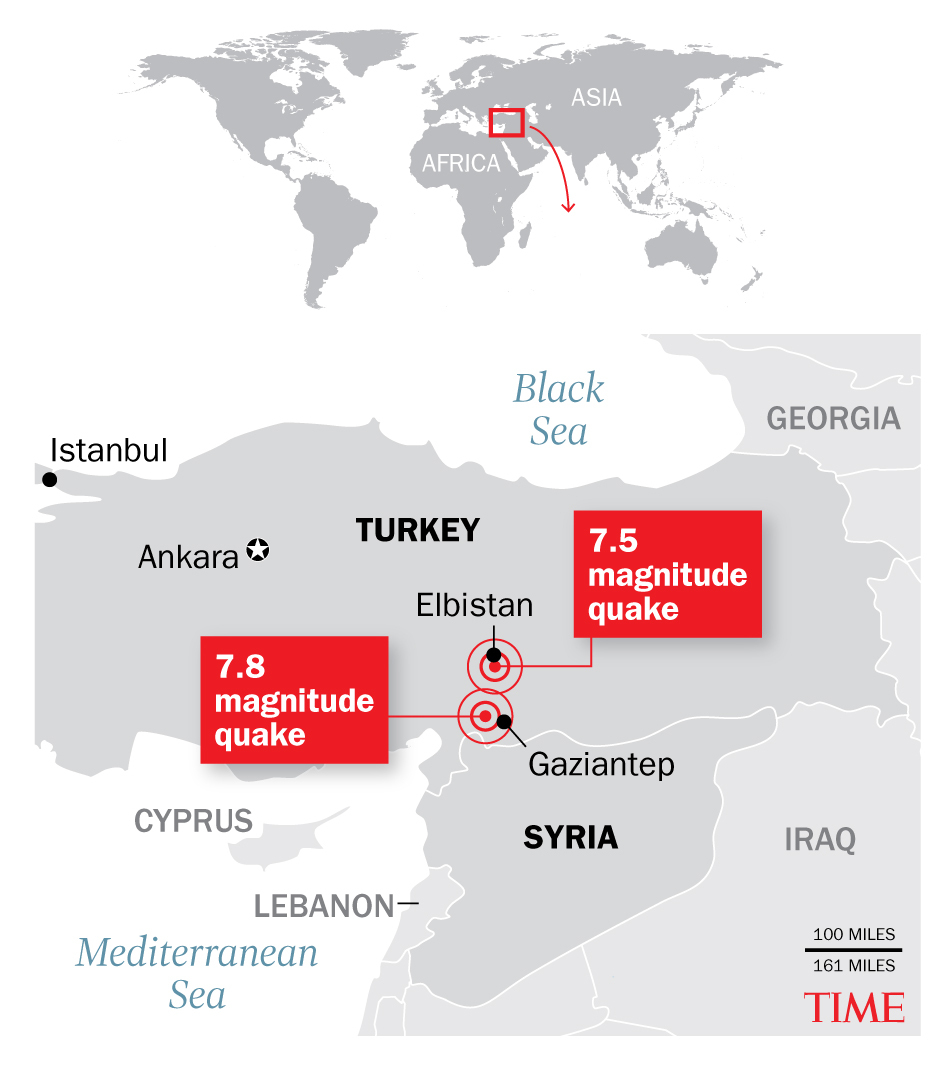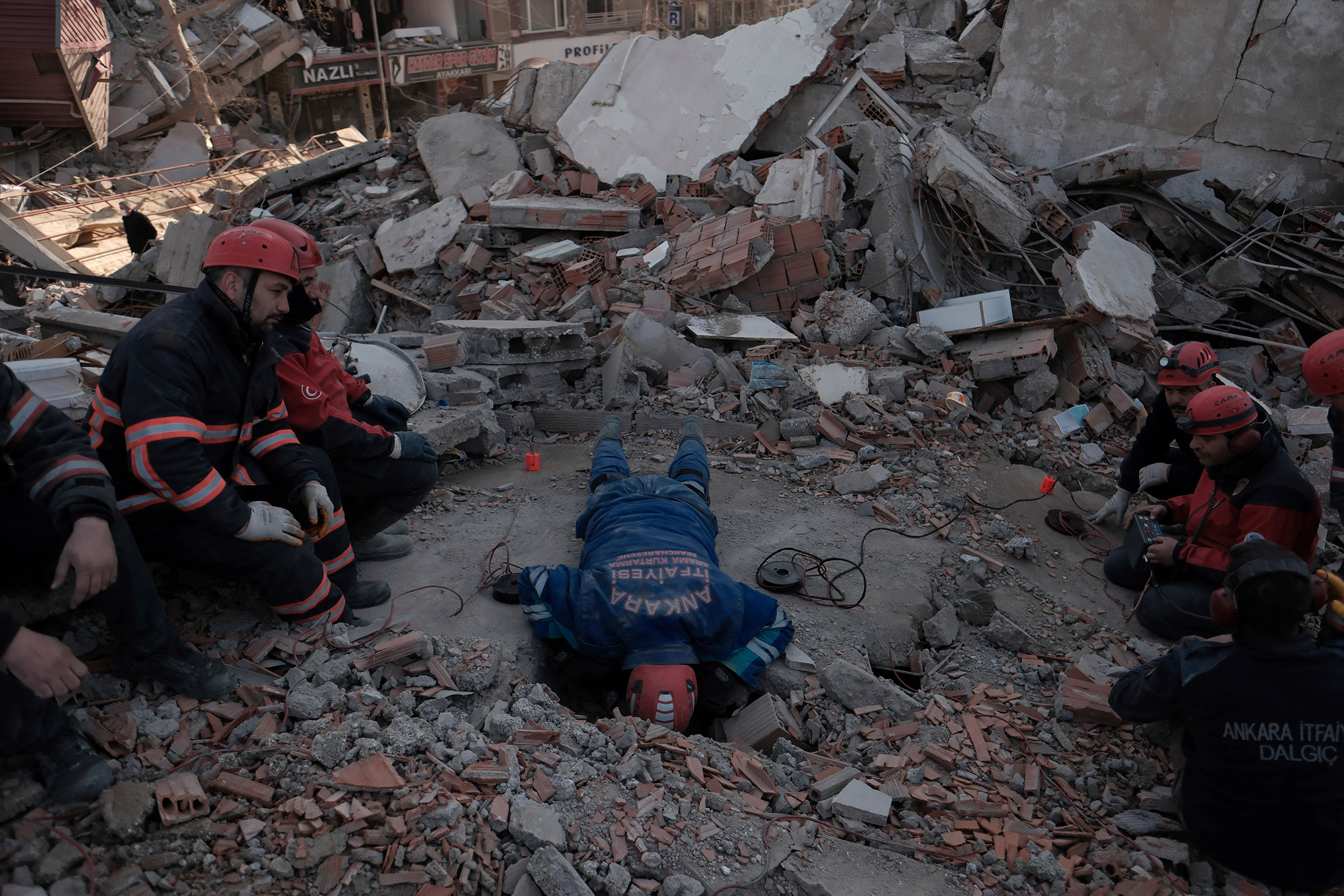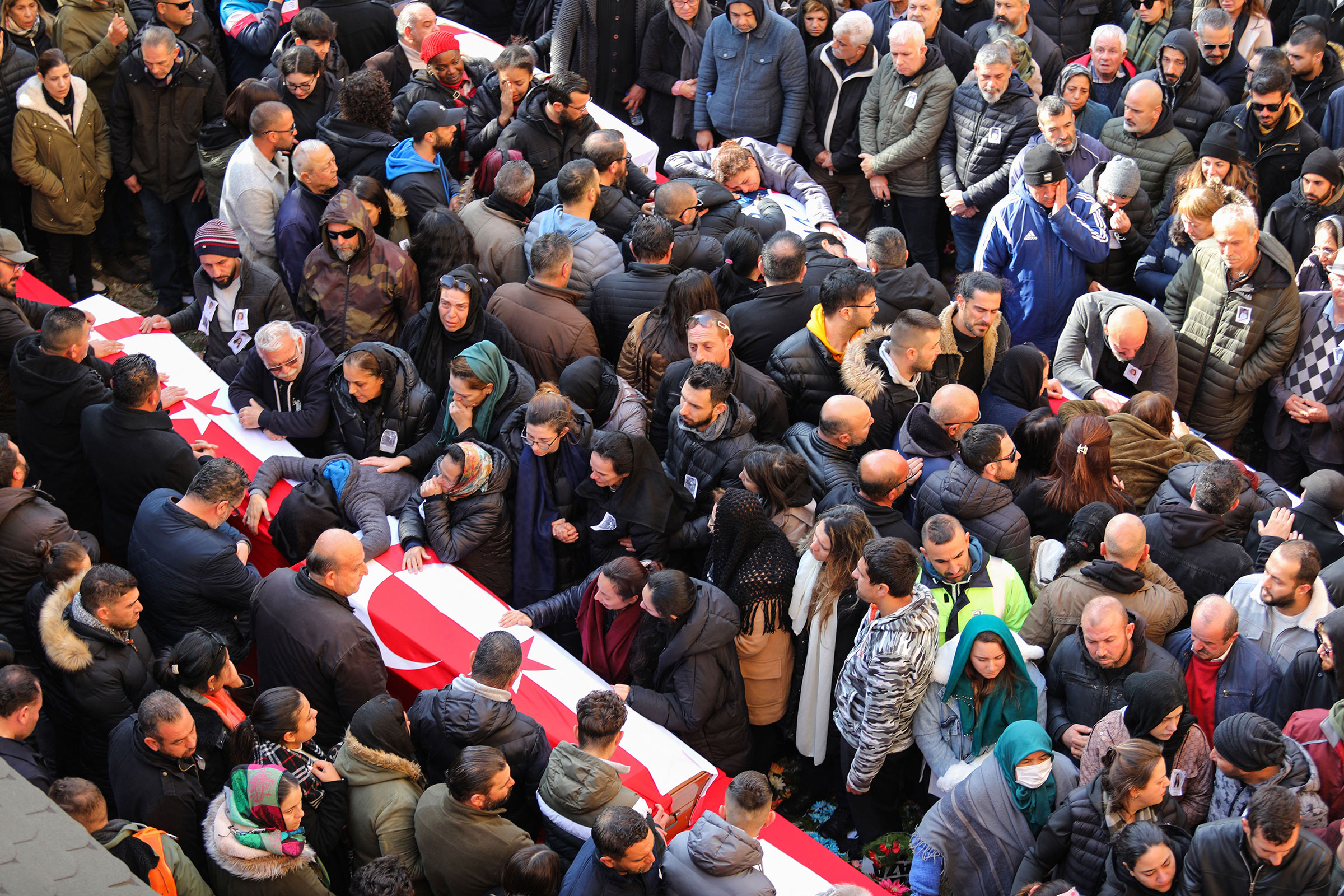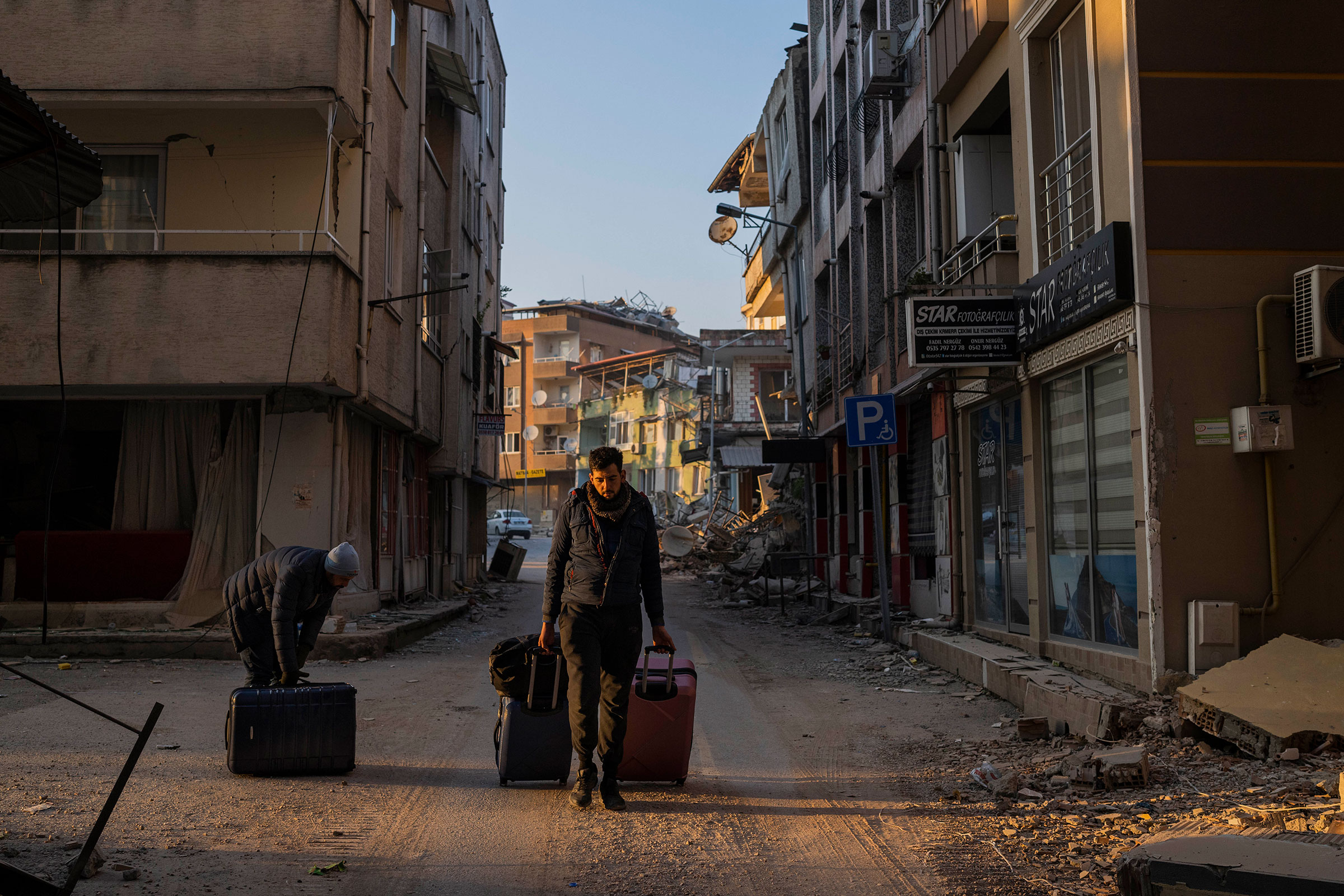When a 7.8 magnitude earthquake struck southeastern Turkey and northwestern Syria early Monday morning local time, its tremor could be felt as far afield as Lebanon, Cyprus, Greece, Israel, and the Palestinian territories. A second quake, which recorded a magnitude of 7.5, struck just 9 hours later.
Both countries at the center are still reeling from the devastating aftermath, rescue workers on the ground tell TIME. So far, more than 37,000 people have been killed as a result of the quakes, and tens of thousands more have been injured. Thousands of buildings have also been reduced to rubble.
Though earthquakes are not uncommon in this part of the world, this week’s are believed to be the largest and deadliest to hit Turkey in decades. Here’s what we know so far.
When and where did the earthquakes in Turkey occur?
The initial earthquake struck the southern Turkish city of Gaziantep, roughly 150 miles away from the Turkey-Syria border, at 4:17 a.m. local time at a depth of about 11 miles, according to the U.S. Geological Survey. The second earthquake, the epicenter of which was roughly 80 miles north of Gaziantep in Turkey’s Kahramanmaras province, struck at 1:24 p.m. local time and was six miles deep, according to USGS.

More than 300 aftershocks rumbled after the initial quakes, according to Turkey’s Vice President Fuat Oktay.
How big is a 7.8 quake on the local magnitude scale?
An earthquake of magnitude 2.5 or less can pass by undetected, but an earthquake with a magnitude of 7.0 or higher is classified as a “major earthquake,” which can cause serious damage. A magnitude 8.0 or higher earthquake, considered “a great earthquake,” is capable of destroying entire communities.
While the magnitude of an earthquake denotes its size and strength, the potential damage caused by a quake is also determined by its depth (the shallower the quake, the more damaging) and its proximity to population centers.
In a tweet, U.S. Geological Survey seismologist Susan Hough likened the size of the initial earthquake in Turkey to San Francisco’s Great Earthquake of 1906, which left more than 3,000 dead and much of the city in ruin.
Are Turkey and Syria prone to earthquakes?
Earthquakes are not uncommon in Turkey. Most of the country is situated on the Anatolian Plate, which borders two major fault lines: the North Anatolian fault, which stretches across the country from west to east, and the East Anatolian fault, which is in eastern Turkey. The former has been the site of several disastrous earthquakes, according to the Geological Society of London, including the 1939 earthquake in northeastern Turkey that resulted in the deaths of 30,000 people.
Monday’s initial 7.8 magnitude earthquake is believed to have occurred on either the East Anatolian fault zone or the Dead Sea transform fault zone, according to USGS.

What is the scale of the damage?
The death toll has been staggering and has surpassed 37,000 people. As of Feb. 14, 31,974 deaths were reported in Turkey and more than 5,800 in Syria, according to the U.N. and Syrian government. Tens of thousands more have been injured following the earthquakes. The World Health Organization warned that 23 million people could be affected by the disaster.
Ismail Al Abdullah, a White Helmets volunteer contributing to rescue efforts near the Syrian-Turkish border, tells TIME that the aftermath of the earthquakes have been nothing short of “heartbreaking.” In the Syrian village of Sarmadā, where he is based, at least five buildings have collapsed, leaving many families trapped beneath the rubble.
“We tried our best to rescue them,” says Al Abdullah. “But we couldn’t. We couldn’t.”
As a veteran of the White Helmets, which was established as a volunteer corps of first responders during the Syrian Civil War, Al Abdullah isn’t new to search and rescue efforts. But even he admits that the scale of yesterday’s earthquakes pose an unprecedented challenge. “We’ve dealt with bombing, but this kind of natural disaster is bigger than us.”
The U.N. Refugee Agency has warned that more than 5 million people in Syria may need shelter following the quakes.
More than 1 million people have been left homeless in Turkey following the earthquakes.
While the full scale of the infrastructure damage in both Syria and Turkey is yet to be fully known, Turkey’s environment minister Murat Kurum said 24,921 buildings collapsed or were heavily damaged in the country.

What the earthquakes mean for Syrian refugees
The densely-populated northwestern region of Syria impacted by the earthquakes is already home to more than 4 million people who rely on humanitarian assistance, according to the U.N. Office for the Coordination of Humanitarian Affairs.
Many are internally displaced persons who have fled for opposition-controlled areas since the Syrian conflict broke out more than a decade ago. The region is controlled by various armed groups and relies heavily on international aid, most of which is delivered via Turkey.
Read More: Earthquakes Struck the Heart of the World’s Largest Refugee Population. Here’s How to Help
However, aid has been slow to arrive in northern Syria, leaving many in the war-torn nation angry over the lack of international assistance.
The government of President Bashar al-Assad has blamed the lack of aid on Western sanctions but aid groups dispute this. Only one border crossing, Bab al-Hawa, is used to deliver aid into Syria via southern Turkey. On Feb. 13, the U.N. announced that two other border crossings, Bab al-Salam and al-Raee, would be opened for 3 months following negotiations with the Assad government.
“We hope that the agreement will last as long as we need to use it. We will start using it as quickly as possible and I don’t want to make any assumptions, the only thing I want to assume is that people will put politics aside wherever they stand in this conflict,” U.N. Secretary General António Guterres’ spokesman Stéphane Dujarric told the BBC.
On Feb. 12, the White Helmets said at least 550 buildings were completely collapsed and more than 1,570 were severely damaged.
The region had already been grappling with a cholera outbreak before the earthquakes.

How have Turkish authorities and President Erdoğan responded?
At least 218,406 people are assisting with Turkey’s disaster response in affected regions, according to the Turkish Disaster and Emergency Management Presidency (AFAD).
Following the quakes, Turkey closed roads to the hard hit cities of Hatay, Kahramanmaraş, and Adıyaman to all vehicles except those aiding in search and rescue efforts, amid deep logistical challenges. Severe weather conditions including temperatures hovering around freezing hampered search and rescue efforts in Turkey and Syria.
Turkish President Recep Tayyip Erdoğan declared a week-long period of national mourning as well as a state of emergency for three months in 10 provinces.
On Feb. 8, Erdoğan traveled to the worst hit area of the quakes in Kahramanmaras and Hatay as well as Pazarcik. The trip came amid growing criticism of the government’s handling of the crisis.
“Where are the tents, where are food trucks?” Melek, 64, told the BBC from Antakya.
On Feb. 7 in an address, Erdoğan shot back at criticism of the government’s handling of the disaster response as “fake news and distortions” and warned those attempting to “cause social chaos,” according to the Washington Post.
Following the address, a state prosecutor launched a criminal investigation into two journalists, Merdan Yanardağ and Enver Aysever, who criticized the government’s handling of the crisis, the Washington Post reported, citing the German-based Turkish Minute.
On Feb. 12, Oktay said the government identified 131 people responsible for the collapse of thousands of buildings. Of them, 114 people had been taken into custody, Oktay added.
Warnings over building construction in Turkey
Turkey’s Union of Engineers and Architects (TMMOB) have long been sounding the alarm on the lack of earthquake infrastructure. Turkey’s location on the Anatolian Plate means that damaging earthquakes are a matter of when, not if.
After a devastating earthquake hit the country in 1999 and killed some 17,000 people, the government at the time promised to reform the country’s earthquake infrastructure—pledging to create new construction standards and strengthen existing buildings. The plan involved designating hundreds of urban spaces as evacuation points in case of emergency. But, over the years, an explosion of new developments undid many of the planned earthquake readiness improvements, and open air evacuation zones were converted into high rises, NPR reported in 2017.
“This place you see in front of us was a public green space, and after the 1999 earthquake, it was designated as a public meeting area,” lawmaker Gursel Tekin told NPR at the time. “Unfortunately, now it is only a monstrous concrete mountain.”
In the aftermath of a 5.9 magnitude earthquake at the end of 2022, TMMOB released a statement saying that “our country has failed in terms of what needs to be done before the earthquake.”
The union added that site supervision “continues to be seen as a procedure on paper only,” noting that, “It is essential that the design, construction and inspection processes are carried out in a correct and vigorous way in order to ensure the safety of buildings against earthquakes. In each of these three pillars of safe construction, it is known that there are serious problems both legally and in practice.”

How the international community responded to the earthquakes
Oktay said Feb. 7 that 3,294 search and rescue teams from 14 countries were in the country and assisting relief efforts.
In a statement, the European Union said it is also directing its satellite system to help map the destruction caused by the quake and assist search and rescue efforts.
On Feb. 7, Erdoğan confirmed that in addition to NATO and the European Union, 45 countries had reached out to Ankara with offers of assistance, including the United States and even war-torn Ukraine.
On Feb. 9, President Joe Biden tweeted that the U.S. would provide $85 million in humanitarian aid to Turkey and Syria, and the U.S. Treasury Department eased sanctions on Syria for 180 days so that the country’s embargoes would “not stand in the way of life-saving efforts.”
China has also pledged $6 million in aid to Turkey.
Russia’s emergency ministry also sent out teams. Moscow is the most important foreign power operating in Syria.
However, rescue teams are winding down operations in both Turkey and Syria, as hopes of finding further survivors fade.

How to donate and help victims of the earthquakes
International relief efforts are well underway. The International Federation of Red Cross and Red Crescent Societies has announced that it is launching “immediate cash assistance” from its Disaster Response Emergency Fund to help relief efforts. The International Rescue Committee, an organization that responds to the most serious humanitarian crises, are on the ground and has set up a fund to assist families in Turkey and Syria.
The Union of Medical Care and Relief Organisations, which provides healthcare in opposition-held parts of northwestern Syria, is also soliciting urgent international aid. As is the Syrian American Medical Society and the White Helmets.
Other charitable organizations such as Oxfam, Action for Humanity, CARE, and Human Appeal have launched fundraisers to support their own teams working on the ground. You can find more ways to donate here.
—With reporting by Simmone Shah.
More Must-Reads from TIME
- Donald Trump Is TIME's 2024 Person of the Year
- Why We Chose Trump as Person of the Year
- Is Intermittent Fasting Good or Bad for You?
- The 100 Must-Read Books of 2024
- The 20 Best Christmas TV Episodes
- Column: If Optimism Feels Ridiculous Now, Try Hope
- The Future of Climate Action Is Trade Policy
- Merle Bombardieri Is Helping People Make the Baby Decision
Write to Yasmeen Serhan at yasmeen.serhan@time.com